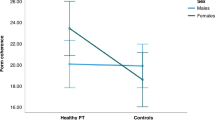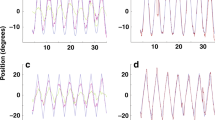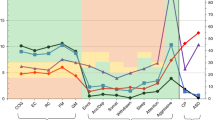Abstract
Background
The ability to perceive and process visuospatial information is a condition for broader neurodevelopment. We examined the association of early visuospatial attention and processing with later neurodevelopmental outcome in very preterm infants.
Methods
Visuospatial attention and processing was assessed in 209 children (<30 weeks gestation) using an easy applicable eye tracking-based paradigm at 1 and 2 years. Average reaction times to fixation (RTF) on specific visual stimuli were calculated, representing time needed for overall attention (Cartoon stimuli) and processing (Motion and Form stimuli). Associations between RTFs and various measures of development at 2 years including cognitive and motor development (Bayley Scales of Infant and Toddler Development-Third edition; Bayley-III), language (Lexi test) and behavior (Child Behavior Checklist) were examined.
Results
At 1 year, 100 ms slower Cartoon and Motion RTFs were associated with lower cognitive Bayley-III scores (−4.4 points, 95%CI: −7.4; −1.5 and −1.0 points, −1.8; −0.2, respectively). A 100 ms slower Cartoon RTF was associated with a 3.5 (−6.6; −0.5) point decrease in motor Bayley-III score.
Conclusions
Visuospatial attention and motion processing at 1 year is predictive of overall cognitive and motor development 1 year later. The nonverbal eye tracking-based test can assist in early detection of preterm children at risk of adverse neurodevelopment.
Impact
-
Visuospatial attention and processing at 1 year corrected age is predictive for overall cognitive and motor development 1 year later in preterm infants.
-
First study to relate early visuospatial attention and processing with later neurodevelopmental outcome in preterm children.
-
Early detection of preterm children at risk of adverse neurodevelopment, which allows for more timely interventions.
Similar content being viewed by others
Log in or create a free account to read this content
Gain free access to this article, as well as selected content from this journal and more on nature.com
or
References
Pierrat, V. et al. Neurodevelopmental outcome at 2 years for preterm children born at 22 to 34 weeks’ gestation in France in 2011: EPIPAGE-2 cohort study. BMJ 358, 3448 (2017).
Serenius, F. et al. Neurodevelopmental outcomes among extremely preterm infants 6.5 years after active perinatal care in Sweden. JAMA Pediatr. 170, 954–963 (2016).
Mangin, K. S., Horwood, L. J. & Woodward, L. J. Cognitive development trajectories of very preterm and typically developing children. Child Dev. 88, 282–298 (2017).
Twilhaar, E. S. et al. Academic performance of children born preterm: a meta-analysis and meta-regression. Arch. Dis. Child Fetal Neonatal Ed. 103, F322–F330 (2018).
O’Reilly, H., Johnson, S., Ni, Y., Wolke, D. & Marlow, N. Neuropsychological outcomes at 19 years of age following extremely preterm birth. Pediatrics 145, e20192087 (2020).
Doyle, L. W. et al. Long term follow up of high risk children: who, why and how? BMC Pediatrics 14, 279 (2014).
Kallioinen, M., Eadon, H., Murphy, M. S. & Baird, G. Developmental follow-up of children and young people born preterm: summary of NICE guidance. BMJ 358, j3514 (2017).
Hack, M. et al. Poor predictive validity of the Bayley Scales of Infant Development for cognitive function of extremely low birth weight children at school age. Pediatrics 116, 333 (2005).
O’Shea, T. M. et al. Accuracy of the Bayley-II Mental Development Index at 2 Years as a predictor of cognitive impairment at school age among children born extremely preterm. J. Perinatol. 38, 908–916 (2018).
Aarnoudse-Moens, C. S. H., Weisglas-Kuperus, N., van Goudoever, J. B. & Oosterlaan, J. Meta-analysis of neurobehavioral outcomes in very preterm and/or very low birth weight children. Pediatrics 124, 717–728 (2009).
de Kieviet, J. F., Piek, J. P., Aarnoudse-Moens, C. S. H. & Oosterlaan, J. Motor development in very preterm and very low-birth-weight children from birth to adolescence: a meta-analysis. JAMA 302, 2235–2242 (2009).
Woodward, L. J. et al. Very preterm children show impairments across multiple neurodevelopmental domains by age 4 years. Arch. Dis. Child Fetal Neonatal Ed. 94, F339–F344 (2009).
Nguyen, T.-N.-N. et al. Developmental trajectory of language from 2 to 13 years in children born very preterm. Pediatrics 141, e20172831 (2018).
Atkinson, J. & Braddick, O. Visual and visuocognitive development in children born very prematurely. Prog. Brain Res. 164, 123–149 (2007).
Braddick, O. & Atkinson, J. Development of human visual function. Vis. Res. 51, 1588–1609 (2011).
Ricci, D. et al. Early visual assessment in preterm infants with and without brain lesions: correlation with visual and neurodevelopmental outcome at 12 months. Early Hum. Dev. 87, 177–182 (2011).
Fazzi, E. et al. Cognitive visual dysfunctions in preterm children with periventricular leukomalacia. Dev. Med. Child Neurol. 51, 974–981 (2009).
Pel, J. J. M. et al. Early identification of cerebral visual impairments in infants born extremely preterm. Dev. Med. Child Neurol. 58, 1030–1035 (2016).
Guzzetta, A. et al. Motion perception in preterm children: role of prematurity and brain damage. NeuroReport 20, 1339–1343 (2009).
van Gils, M. M. et al. Brain damage and visuospatial impairments: exploring early structure-function associations in children born very preterm. Pediatr. Neurol. https://doi.org/10.1016/j.pediatrneurol.2019.12.01 (2020).
Molloy, C. S. et al. The contribution of visual processing to academic achievement in adolescents born extremely preterm or extremely low birth weight. Child Neuropsychol. 23, 361–379 (2015).
Stjerna, S. et al. Visual fixation in human newborns correlates with extensive white matter networks and predicts long-term neurocognitive development. J. Neurosci. 35, 4824–4829 (2015).
Kaul, Y. F. et al. Visual tracking in very preterm infants at 4 mo predicts neurodevelopment at 3 y of age. Pediatr. Res. 80, 35–42 (2016).
Pel, J. J. M., Manders, J. C. W. & van der Steen, J. Assessment of visual orienting behaviour in young children using remote eye tracking: methodology and reliability. J. Neurosci. Methods 189, 252–256 (2010).
Kooiker, M. J. G., van der Steen, J. & Pel, J. J. M. Reliability of visual orienting response measures in children with and without visual impairments. J. Neurosci. Methods 233, 54–62 (2014).
Kooiker, M. J. G., van der Steen, J. & Pel, J. J. M. Development of salience-driven and visually-guided eye movement responses. J. Vision. 16, 1–11 (2016).
Kooiker, M. J. G., Swarte, R. M. C., Smit, L. S. & Reiss, I. K. M. Perinatal risk factors for visuospatial attention and processing dysfunctions at 1 year of age in children born between 26 and 32 weeks. Early Hum. Dev. 130, 71–79 (2019).
Roelants, J. A. et al. First week weight dip and reaching growth targets in early life in preterm infants. Clin. Nutr. 37, 1526e1533 (2018).
Ricci, D. et al. Early visual and neuro-development in preterm infants with and without retinopathy. Early Hum. Dev. 148, 105134 (2020).
Fantz, R. I. Visual perception from birth as shown by pattern selectivity. Ann. N.Y. Acad. Sci. 118, 793–814 (1965).
Bayley, N. Bayley Scales of Infant and Toddler Development, 3rd edn. (The Psychological Corporation, San Antonio, TX, 2006).
Schlichting, J. E. P. T., van Eldrik, M. C. M., Lutje Spelberg, H. C., van der Meulen, S. J. & van der Meulen, B. F. Schlichting Test for Expressive Language (Berkhout BV, Nijmegen, The Netherlands, 1987).
Achenbach, T. M. & Rescorla, L. Manual for the ASEBA Preschool Forms & Profiles (Research Center for Children, Youth, and Families, University of Vermont, Burlington, 2000).
Tottman, A. C. et al. Sex-specific relationships between early nutrition and neurodevelopment in preterm infants. Pediatr. Res. 87, 872–878 (2020).
van Houdt, C. A., van Wassenaer-Leemhuis, A. G., Oosterlaan, J., van Kaam, A. H. & Aarnoudse-Moens, C. S. H. Developmental outcomes of very preterm children with high parental education level. Early Hum. Dev. 133, 11–17 (2019).
Bauer, S. E. et al. Factors associated with neurodevelopmental impairment in bronchopulmonary dysplasia. J. Pediatr. 218, 22–27 (2020).
Weisz, D. E., More, K., McNamara, P. J. & Shah, P. S. PDA ligation and health outcomes: a meta-analysis. Pediatrics 133, e1024–e1046 (2014).
Benavente-Fernandez, I. et al. Association of socioeconomic status and brain injury with neurodevelopmental outcomes of very preterm children. JAMA Netw. Open 2, e192914 (2019).
Kooiker, M. J. G., Verbunt, H. J. M., van der Steen, J. & Pel, J. J. M. Combining visual sensory functions and visuospatial orienting functions in children with visual pathology: a longitudinal study. Brain Dev. 41, 135–149 (2019).
Ramel, S. E., Haapala, J., Super, J., Boys, C. & Demerath, E. W. Nutrition, illness and body composition in very low birth weight preterm infants: implications for nutritional management and neurocognitive outcomes. Nutrients 12, 145 (2020).
Adams-Chapman, I. et al. Neurodevelopmental impairment among extremely preterm infants in the Neonatal Research Network. Pediatrics 141, e20173091 (2018).
Serenius, F. et al. Neurodevelopmental outcome in extremely preterm infants at 2.5 years after active perinatal care in Sweden. JAMA 309, 1810–1820 (2013).
Brouwer, M. J. et al. Preterm brain injury on term-equivalent age MRI in relation to perinatal factors and neurodevelopmental outcome at two years. PLoS ONE 12, e0177128 (2017).
Verhagen, E. A. et al. Cerebral oxygenation is associated with neurodevelopmental outcome of preterm children at age 2 to 3 years. Dev. Med. Child Neurol. 57, 449–455 (2015).
Charkaluk, M.-L. et al. Association of language skills with other developmental domains in extremely, very, and moderately preterm children: EPIPAGE 2 cohort study. J. Pediatr. 208, 114–120 (2019).
Posner, M. I., Snyder, C. R. & Davidson, B. J. Attention and the detection of signals. J. Exp. Psychol. 109, 160 (1980).
Geldof, C. J. A. et al. Visual sensory and perceptive functioning in 5-year-old very preterm/very-low-birthweight children. Dev. Med. Child Neurol. 56, 862–868 (2014).
Geldof, C. J. A., van Wassenaer-Leemhuis, A. G., Dik, M., Kok, J. H. & Oosterlaan, J. A functional approach to cerebral visual impairments in very preterm/very-low-birth-weight children. Pediatr. Res. 78, 190–197 (2015).
Sekigawa-Hosozawa, M., Tanaka, K., Shimizu, T., Nakano, T. & Kitazawa, S. A group of very preterm children characterized by atypical gaze patterns. Brain Dev. 39, 218–224 (2017).
Rommelse, N. N. J., van der Stigchel, S. & Sergeant, J. A. A review on eye movement studies in childhood and adolescent psychiatry. Brain Cognition. 68, 391–414 (2008).
Ebesutani, C. et al. Concurrent validity of the Child Behavior Checklist DSM-oriented scales: correspondence with DSM diagnoses and comparison to syndrome scales. J. Psychopathol. Behav. Assess. 32, 373–384 (2010).
Nakamura, B. J., Ebesutani, C., Bernstein, A. & Chorpita, B. F. A psychometric analysis of the Child Behavior Checklist DSM-Oriented Scales. J. Psychopathol. Behav. Assess. 31, 178–189 (2009).
Mesman, J. & Koot, H. M. Early preschool predictors of preadolescent internalizing and externalizing DSM-IV diagnoses. J. Am. Acad. Child Adolesc. Psychiatry 40, 1029–1036 (2001).
de la Osa, N., Granero, R., Trepat, E., Domenech, J. M. & Ezpeleta, L. The discriminative capacity of CBCL/1½‑5‑DSM5 scales to identify disruptive and internalizing disorders in preschool children. Eur. Child Adolesc. Psychiatry 25, 17–23 (2016).
Dutton, G. N. The spectrum of cerebral visual impairment as a sequel to premature birth: an overview. Doc. Ophthalmol. 127, 69–78 (2013).
Acknowledgements
The authors are grateful to all children and parents for their cooperation. The authors thank the students from the Neuroscience Department for their assistance in eye tracking data acquisition; the psychologists and physiotherapists from the Neonatology Department for their help in data collection; and Arianne Jacobse for logistic support. The Blik Vooruit Study received unrestricted financial support from NOVUM (stichtingnovum.org; grant number OI0342).
Author information
Authors and Affiliations
Contributions
Substantial contributions to conception and design: M.J.V., J.A.R., I.K.M.R., J.J.M.P, K.F.M.J and M.J.G.K.; acquisition of data: V.A.A.B., J.A.R., N.R., R.M.C.S and M.J.G.K., or analysis and interpretation of data: V.A.A.B., M.J.V., J.A.R., N.R. and M.J.G.K. Drafting the article: V.A.A.B, M.J.V. and M.J.G.K.; revising the article critically for important intellectual content: all authors. Final approval of the version to be published: all authors.
Corresponding author
Ethics declarations
Competing interests
The authors declare no competing interests.
Ethics
Parental informed consent was obtained for all participants.
Additional information
Publisher’s note Springer Nature remains neutral with regard to jurisdictional claims in published maps and institutional affiliations.
Supplementary information
Rights and permissions
About this article
Cite this article
Beunders, V.A.A., Vermeulen, M.J., Roelants, J.A. et al. Early visuospatial attention and processing and related neurodevelopmental outcome at 2 years in children born very preterm. Pediatr Res 90, 608–616 (2021). https://doi.org/10.1038/s41390-020-01206-7
Received:
Revised:
Accepted:
Published:
Issue date:
DOI: https://doi.org/10.1038/s41390-020-01206-7
This article is cited by
-
Visuospatial outcomes of a prospective national cohort of young adults with very low birthweight
Pediatric Research (2025)
-
Exposure to the parents’ speech is positively associated with preterm infant’s face preference
Pediatric Research (2024)
-
Visual attention and processing function in relation to executive functioning in very preterm–born children aged 3 years: a prospective cohort study
European Journal of Pediatrics (2024)



